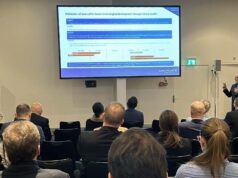
Chordate Medical tackles chronic migraines
About every seventh person in Sweden suffers from migraine – a disease characterised by intense and throbbing headaches in combination with a number of other ailments. Patients suffering from chronic migraine have headaches every other day, on average, which leads to an enormous burden on both the individual and on society as a whole. Chordate Medical wants to play a part in reducing this burden with a treatment called Kinetic Oscillation Stimulation – a fast, nerve-stimulating treatment with the potential to be both long-lasting and without unexpected side effects.
There is a significant demand for new treatment methods for migraine as current treatment strategies are considered to have ![]() insufficient effects. Some treatment methods also cause significant side effects. The medical technology company Chordate Medical wants to fill the therapeutic need with its Kinetic Oscillation Stimulation treatment (K.O.S), a treatment method that uses vibrations to stimulate the nerves in the mucous membranes of the nose.
insufficient effects. Some treatment methods also cause significant side effects. The medical technology company Chordate Medical wants to fill the therapeutic need with its Kinetic Oscillation Stimulation treatment (K.O.S), a treatment method that uses vibrations to stimulate the nerves in the mucous membranes of the nose.
The company’s goal is to help people with chronic migraines to prevent severe headaches and reduce the number of headache days. The capacity of K.O.S treatment to do just that is now being evaluated in a clinical study conducted at 10 clinics throughout Germany and Finland. BioStock has previously interviewed Chordate Medical’s CEO Anders Weilandt to find out more about the treatment, the ongoing study and the company’s future plans. Read the interview here.
Troublesome symptoms
About 15 per cent of Sweden’s adult population is estimated to suffer from migraine – that is, over 1.5 million people. However, the severe headache symptoms are not evenly distributed over the entire population, since 65 per cent of the affected people are women. Migraine is, to some extent, hereditary, and about 70 per cent of migraine patients state that a close relative also has or has suffered from migraines. Migraine attacks start mainly during adolescence and increase in middle age, and then decrease with increasing age by about 30 per cent per ten-year period. It is uncommon for migraines to debut after the age of 50. Read more.
Migraine is characterized by severe pulsating headaches that recur in attacks – migraine attacks -that often occur in combination with nausea, sound and light sensitivity, visual disturbances or vomiting. The word migraine is derived from the Greek word for ”half head”, which is explained by the fact that the headache in migraine is usually one-sided. The pain is usually located around one eye or on one side of the head.
Migraine attacks can last between half an hour and three days and can be triggered by many different stimuli, such as stress, lack of sleep, hormonal changes or certain foods and beverages. The headache may come on suddenly or with certain warning signs, so-called aura symptoms, before the migraine attack breaks out. Migraines with aura can include visual disturbances with flicker, tingling and numbness, speech difficulties or hearing impairments. The aura usually disappears within 10 to 30 minutes and is then followed by the headache.
Chronic migraine
A distinction is usually made between episodic migraine, which occurs from time to time, and chronic migraine. Chronic migraine means that you suffer from headache for at least 15 days each month and that the headaches are classified as migraines on at least 8 of these days.
It is patients with chronic migraine, i.e. the most serious form of migraine, that Chordate Medical mainly targets with its K.O.S treatment. The method, which is based on nerve stimulation in the nasal mucosa through vibration, is expected to be used preventively to reduce the number of headache days, as an ongoing study intends to show. The clinical study involves approximately 140 people at 10 migraine clinics and the goal is to prove clinical effect. The last patient is expected to be done with the treatment by the end of 2020, after which study results will be communicated during Q1 2021. The results will then form the basis for a CE-marking application regarding K.O.S treatment of chronic migraine.
Chordate Medical’s K.O.S treatment is already CE-marked for the treatment of chronic nasal congestion (rhinitis) and available for sale in the EU, Israel and Saudi Arabia.
Quality of life and society are severely affected
Unbearable headaches due to migraine are part of everyday life for a lot of people. It is estimated that between 110 and 170 million people in the world suffer from chronic migraine. Having a headache more than half of all days means that many people have to limit their lives and take painkillers that lead to severe side effects. Everyday life can be difficult to plan, and this, in turn, leads to uncertainly, anxiety and frustration. In addition, the fatigue and pain the migraine attacks carry with them can affect people’s moods and social lives in a negative way. According to the WHO, anxiety and depression are more common among people suffering from migraines.
It is usually not possible to work during a migraine attack, which means that many of the patients are forced to take sick leave several days a month. The high sick leave rates lead to large costs for society in the form of both healthcare and loss of production. Through the Eurolight Project, the total cost in the EU for headache disorders among adults has been estimated at 173 billion euros per year, of which migraines account for 64 percent of the costs.
Today’s drug treatments have substandard effects
How migraines are treated depends on the severity of the attacks, how often they occur and whether the patient has any other diseases. Chronic migraines are mainly treated with pharmaceutical drugs that have been shown to be ineffective for a lot of people, leaving a large number of patients untreated.
Most pharmaceutical drugs that are indicated for migraines are only designed to treat acute migraine attacks, i.e. when the attack has already started. A few pharmaceutical drugs are intended to prevent migraine attacks but are in turn very expensive and unsuitable for certain patient groups, such as pregnant women or people with heart conditions. In addition, these medicines often lose their therapeutic effect over time and need to be changed to stronger pharmaceutical drugs.
There is a high demand for migraine drugs even if the effect is often insufficient. Global sales of migraine drugs are estimated to approximately 83.7 billion SEK in 2026 with an annual growth of just over 10 percent in the seven largest markets (7MM) – USA, France, Spain, Germany, Italy, UK and Japan.
Botox injections can lead to side effects
An alternative to pharmaceutical drugs is Botox injections into the face and around the head with as many as 30-40 injections per treatment session. It is a preventive migraine treatment that is given at a clinic four times a year. In a previous study, 70 per cent of patients treated with Botox for chronic migraine experienced a 50 per cent reduction in the number of days with headaches. However, Botox is associated with side effects, just as are pharmaceutical drugs. About 1 in 10 people experience pain in the head and neck, drooping eyelids, muscle weakness in the face or rash after the Botox treatment.
For Chordate Medical, the patients currently being treated with Botox injections are an important target group. K.O.S treatment is, for the time being, given in a clinic, just like the Botox treatment, and also with a similar treatment frequency – but at a lower price with a better clinical effect and without unexpected side effects.
Many theories about what migraines are due to
The exact causes of migraines or why some suffer from them remains a mystery, but a number of studies have been conducted to investigate this further. According to one theory, the cause of migraine attacks is a primary defect in the nervous system that leads to increased nerve signaling or a hypersensitivity to nerve signals. Furthermore, researchers at the Universities of Birmingham and Lancaster have shown that migraines can be due to a hyper-excitable visual cortex. Previously, it was thought that migraines were caused by an expansion of the blood vessels in the brain, but now it is believed that the dilation of the blood vessels is the result of another physiological event, not the cause.

Chordate Medical believes that the autonomic nervous system (ANS) is involved given the symptoms commonly associated with migraine attacks; nausea, tearing, nasal congestion and runny nose. The company has shown that their vibration treatment given via the nose affects the variation of the heart rate, which indicates that the treatment also has an effect on the autonomic nervous system. According to the company’s theory, a ”normalization” of the autonomic nervous system takes place with the K.O.S treatment, which can help people with migraines who are assumed to have an imbalance/irritation in the autonomic nervous system.
Thus, the company has high expectations of being able to help people with chronic migraine and challenge today’s treatment methods with its K.O.S treatment – a simple treatment that only takes 20 minutes to complete and which is expected to have a long-term effect without unexpected side effects.
Also read Chordate Medical’s method treats without surgery or drugs (August 31, 2020)
The content of BioStock’s news and analyses is independent but the work of BioStock is to a certain degree financed by life science companies. The above article concerns a company from which BioStock has received financing.


